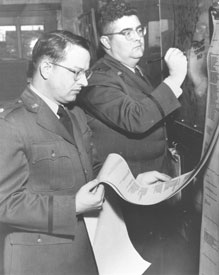A ONE IN TWENTY-MILLION CHANCE–The True Story of the First Tornado Forecast–Part II
PART II

Major Ernest J. Fawbush (left) and Captain Robert C. Miller examining weather data ca. 1948. Data those days came in via “high speed” (probably about 60 wpm) teletype.
On the morning of March 25, 1948, based on their hurried research, Captain Miller and Major Fawbush noted a significant similarity between the weather charts for that day and March 20, the date of the Tinker tornado. The two forecasters prepared a hand-drawn prognostic chart (computerized progs were still far in the future in 1948) and reached the “unsettling conclusion that central Oklahoma would be in a primary tornado threat area by late afternoon and early evening.”
They notified Brigadier General Borum who arrived at the weather station in short order. He listened thoughtfully to the briefing from Miller and Fawbush, then asked, “Are you planning to issue a tornado forecast for Tinker?”
Silence.
Fawbush finally spoke up. He looked at Miller and said, “Well, it certainly looks like the 20th, right, Bob?”
Miller shuffled uncomfortably, then nodded in agreement. “Yes, sir, it looks very much like it did on the 20th.”
“What would be the critical time?” General Borum asked.
“Five to six p.m.,” Fawbush answered.
“Okay, here’s what we do,” the general said. “Issue a forecast for heavy thunderstorms during that period. That will serve to alert the base and trigger phase A of our new safety plan.”
Miller and Fawbush were “more than delighted with this approach,” knowing they were off the hook for making a tornado forecast. After all, the odds of a second tornado hitting the same spot within 20 years, let alone five days, was less than one in 20,000,000.
By early afternoon, locations west of Tinker began reporting billowing cumulonimbus (thunderstorm clouds). Within an hour, radar picked up the first thunderstorm echoes. The storms appeared to be growing in number and organizing into a squall line. Miller and Fawbush notified General Borum who beat a quick path back to the weather station.
He, along with the two weather officers, spent about ten minutes examining the returns on the radar scope.
“Looks like the squall line is intensifying pretty rapidly,” the general noted.
Miller and Fawbush concurred.
The general continued to peer at the scope. “What time do you expect it to hit Tinker?”
“Around 6 p.m., sir,” Fawbush said. He and Miller glanced at each other, apprehension in their eyes. They knew what the next question was going to be.
General Borum looked directly at the two forecasters. “Are you going to issue a tornado forecast?”
One thing young military officers learn early in their careers is that you don’t say “no” to a general. On the other hand, saying “yes” to issuing a tornado forecast, at least in 1948, was unquestionably a fool’s errand.
Major Fawbush fumbled for an answer. “Well, sir, the situation sure does look like the last one–” he turned to Miller “–doesn’t it, Bob?”
“Yes, very similar to last week,” Miller muttered, lacking anything more insightful to say.
The general rolled his eyes. “God, you two sound like a broken record. If you really believe this situation is like the one last week, it seems logical
to issue a tornado forecast.”
Miller and Fawbush tried to crawl out of the hole they’d just dug for themselves. Miller pointed out the infinitesimal odds against a tornado striking the same location within five days.
“Besides,” Fawbush added, “no one has ever issued an operational tornado forecast.”
General Borum took a step toward the two men, gave them a steely-eyed glare as only a flag officer can, and said, “Then, gentlemen, you are about to set a precedent.”
PART III, the final installment, will be posted Monday.

I really enjoyed your take on the first tornado forecast. E.J. Fawbush was my grandfather. In fact, it wasn’t until the 50 year anniversary of the forecast that I found out about his contributions in the field of meteorology. He passed away when I was very young, but I could imagine just how nervous he was after the warning had been issued. Anyway, it was an entertaining read and I wanted to say thanks for making me smile in remembrance!
Tia,
I have two pictures of my Dad who was a flight engineer on General Borum’s B-17 in the early fifties.
He and his fellow crewmember are standing by the door of the bomber.
You can email me or see it on facebook.
Best,
Ed Colbert